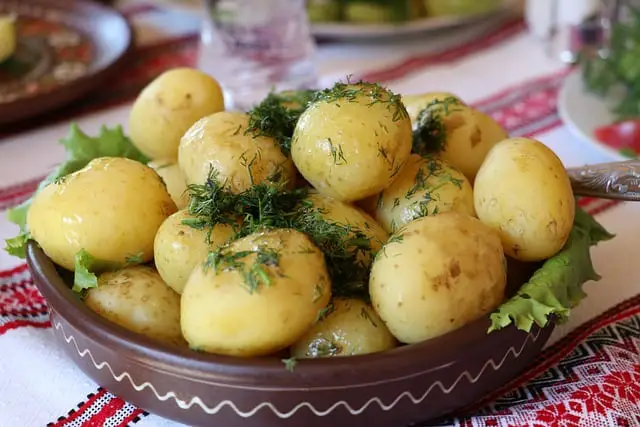You can combine sage and dill in your cooking in variety of dishes and condiments. Sage has a savory and earthy flavor with hints of mint, while dill has a fresh and slightly tangy taste. Combining these two herbs can create a unique and balanced flavor profile in your foods.
Here are some dishes where sage and dill can be combined:
- Roasted Vegetables: Toss vegetables like potatoes, carrots, or squash with olive oil, minced sage, and chopped dill before roasting them for a delicious herb-infused side dish.
- Stuffings and Dressings: Incorporate a mixture of sage and dill into your stuffing or dressing recipes for poultry, adding depth of flavor and a touch of freshness.
- Creamy Dips and Sauces: Blend sage, dill, sour cream, or Greek yogurt, along with other herbs and spices, to create flavorful dips or sauces for vegetables, chips, or seafood.
- Grilled Fish or Seafood: Season fish fillets or seafood with a mixture of minced sage, dill, garlic, lemon juice, and olive oil before grilling for a delightful herb-infused flavor.
- Herb Butter or Compound Butter: Mix softened butter with chopped sage and dill, along with other herbs and seasonings, to create a flavored herb butter to enhance the taste of grilled meats, roasted vegetables, or bread.
Experiment with the combination of sage and dill to find the balance that suits your taste preferences and the specific dish you are preparing. The aromatic and savory notes of sage complement the freshness and tanginess of dill, resulting in a delightful herbaceous flavor experience.
Sage And Dill Comparison
Here’s a comparison table between sage and dill:
| Sage | Dill |
|---|---|
| Sage has a savory and earthy flavor with hints of mint. It is often described as having a warm and slightly peppery taste. | Dill has a fresh and slightly tangy taste. It is known for its distinct flavor profile, often described as grassy, sweet, and slightly anise-like. |
| Sage is a herb commonly used in Mediterranean and European cuisines. It pairs well with meats, poultry, stuffings, and roasted vegetables. | Dill is widely used in European, Middle Eastern, and Scandinavian cuisines. It is often associated with dishes like pickles, fish, sauces, and salads. |
| Sage leaves are small and have a velvety texture. They are typically used fresh or dried. | Dill features delicate feathery leaves and is usually used fresh. Dried dill can also be used, but it tends to lose some of its flavor. |
| Sage has a strong flavor, so it is best used sparingly. A little goes a long way in imparting its distinct taste. | Dill has a more subtle flavor and can be used in larger quantities to enhance the taste of dishes without overpowering them. |
| Sage is known for its potential health benefits, including anti-inflammatory properties and antioxidant effects. | Dill is also believed to have health benefits, such as aiding digestion, promoting sleep, and providing essential nutrients like vitamin C and manganese. |
| Common culinary uses for sage include stuffing, roasted meats, sausages, soups, and pasta dishes. | Dill is often used in dishes like salads, fish, pickles, yogurt-based sauces, dips, and as a garnish for various dishes. |
Both sage and dill offer unique flavors and aromas, and they can complement a wide range of dishes. Whether you’re looking for a savory and minty note (sage) or a fresh and tangy accent (dill), these herbs can add depth and complexity to your culinary creations.
How To Use Sage And Dill In Food Dishes
Both sage and dill can be used in various forms depending on the recipe and personal preference. Here’s a breakdown of the common forms used for each herb:
Sage
- Fresh Leaves: Fresh sage leaves are commonly used in cooking. They can be chopped, minced, or used whole in dishes like stuffings, sauces, and roasted meats.
- Dried Leaves: Dried sage leaves have a more concentrated flavor and are used in recipes that require a longer cooking time, such as stews and slow-cooked dishes.
- Ground Sage: Ground sage is made by grinding dried sage leaves into a powder. It is often used as a seasoning in spice blends, sausages, and soups.
Dill
- Fresh Leaves: Fresh dill leaves are highly aromatic and are commonly used in salads, sauces, fish dishes, and pickles. They can be added as a garnish or incorporated into recipes during cooking.
- Dill Weed: Dill weed refers to the feathery leaves of the dill plant. It can be used fresh or dried and is often added to dishes like dips, dressings, soups, and vegetable dishes.
- Dill Seeds: Dill seeds have a slightly different flavor profile compared to the leaves. They have a stronger taste and are commonly used in pickling, bread, and spice blends.
Both herbs are versatile and can be used in multiple forms depending on the desired intensity of flavor and the specific dish you’re preparing. Fresh forms are often preferred for their vibrant flavors, while dried forms provide a more concentrated taste. Experiment with different forms to discover your preferred way of incorporating sage and dill into your recipes.

